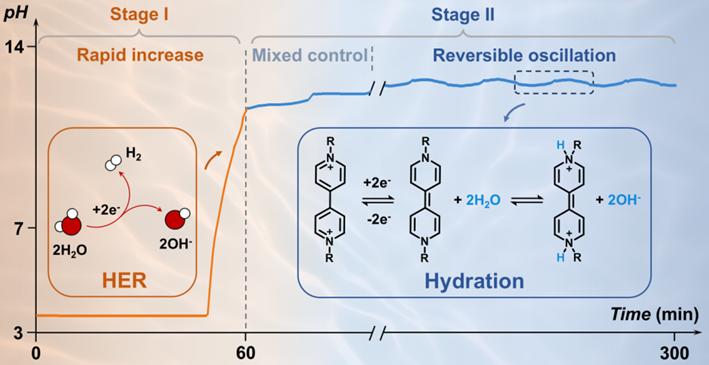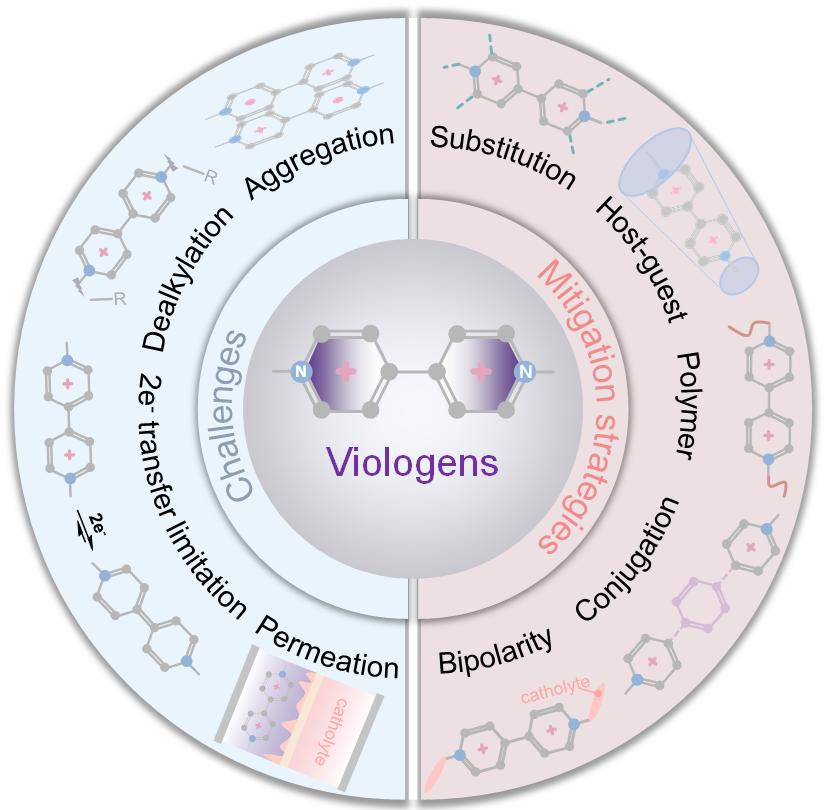Under China’s “dual-carbon” goals, photovoltaic and wind power are becoming central to the energy mix, yet their intermittency and volatility impede large-scale grid integration. Aqueous organic redox flow batteries (AORFBs) are an attractive storage solution because of their low cost, intrinsic safety, and decoupled power/energy design.
Among anolytes, viologen derivatives are widely used owing to low cost, high water solubility and excellent redox reversibility. However, during prolonged cycling, viologen-based anolytes undergo an electrochemical alkalization of unclear origin, causing molecular degradation and rapid capacity fade. The challenge is particularly acute under two-electron transfer, which suppresses effective utilization of the second electron and limits achievable energy density. Elucidating the alkalization mechanism is therefore essential for improving the durability of viologen-based AORFBs.

Addressing this problem, Professor Jiangxuan Song’s group at Xi’an Jiaotong University (XJTU) developed an integrated testing platform that integrates in-situ pH monitoring, gas chromatography and electrochemical testing. This multimodal approach enabled the first unveiling of the two-stage alkalization mechanism in viologen-based anolytes. In the initial stage, hydrogen evolution at low potentials drives an irreversible increase in pH. In the subsequent stage, reversible structural interconversion between quaternary ammonium nitrogen and pyridinic nitrogen sites induces sustained pH oscillations. Guided by this mechanistic understanding, the team validated a mitigation strategy using high-concentration supporting electrolytes that effectively suppressed alkalization. Under two-electron transfer conditions, the optimized system achieved an energy density of 66.9 Wh Lanolyte⁻¹ and retained 99.25% capacity per day over 200 cycles, demonstrating exceptional cycling stability. This study not only advances the understanding of the alkalization mechanism in viologen-based anolytes but also establishes a broadly applicable framework for the design of durable electrolytes for AORFBs.
The research is reported in Angewandte Chemie International Edition as “Uncovering the Electrochemical Origin of Alkalization in Viologen-Based Aqueous Flow Batteries.” Master’s student Zirui Jiang and doctoral student Yunpeng Di are co-first authors; Associate Professor Hao Fan and Professor Jiangxuan Song are corresponding authors. State Key Laboratory for Mechanical Behavior of Materials at Xi'an Jiaotong University is listed as the sole corresponding affiliation.

In related work, the team has conducted systematic studies on molecular design, reaction mechanisms, and stability control of viologen electrolytes. They were recently invited to publish a comprehensive review in Advanced Materials, “Viologen Derivatives in Aqueous Organic Redox Flow Batteries: Progress and Perspectives.” The review summarizes effective strategies—including bipolar molecular design, π-conjugation extension, steric-hindrance engineering, host–guest interactions, and substituent modification—clarifies how these approaches improve stability, solubility, and redox reversibility, and outlines in-situ and ex-situ characterization methods used to probe redox mechanisms, degradation pathways, and aggregation behavior. The guidance offered points toward AORFBs with higher stability and energy density. PhD graduates Hongbin Li and doctoral student Mengke Wen, and master’s student Wenzhang Dong are co-first authors; Associate Professor Hao Fan and Professor Jiangxuan Song are corresponding authors. State Key Laboratory for Mechanical Behavior of Materials is again the sole corresponding affiliation.
This series of studies was supported by the National Natural Science Foundation of China, the Foreign Expert Program of the Ministry of Human Resources and Social Security, the Shaanxi Key R&D Program, the Discipline Innovation and Talent Introduction Program 2.0 (111 Program 2.0), and the XJTU Young Top Talent Program. Portions of the characterization were performed at Instrumental Analysis Center of Xi'an Jiaotong University and the School of Materials Science and Engineering testing platform; theoretical simulations used the XJTU High-Performance Computing Platform.
Article links: https://onlinelibrary.wiley.com/doi/full/10.1002/ange.202514131
https://advanced.onlinelibrary.wiley.com/doi/10.1002/adma.202514004
Group website: https://jxsong.xjtu.edu.cn/


